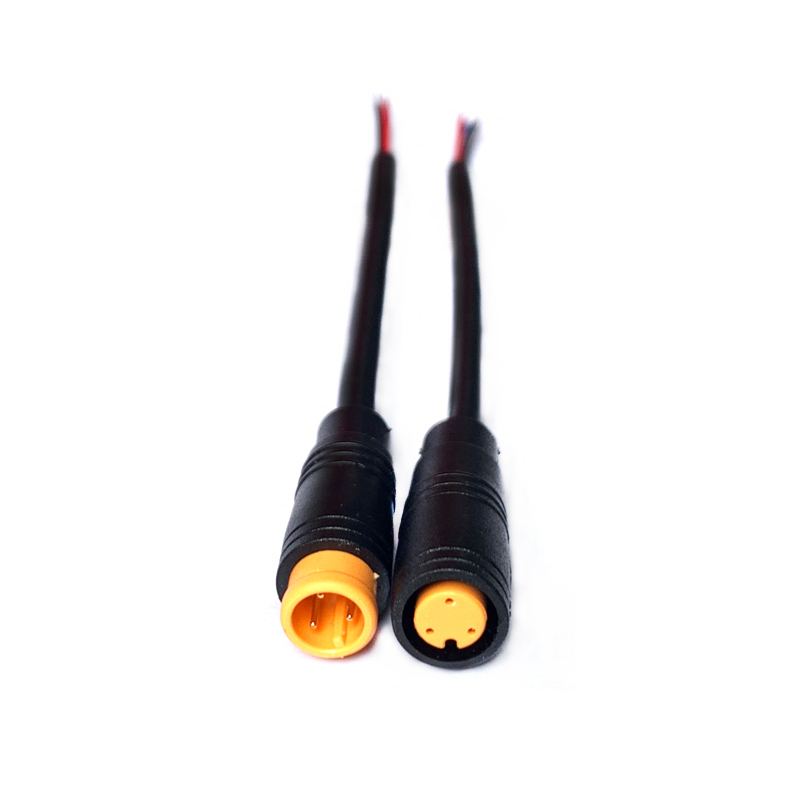News


News

Understanding the Functions of Wire Cores in 3-Pin M8 Waterproof Connectors
Release time:2025-04-16
viewed:235
3-pin M8 waterproof connectors are widely used in industrial automation, sensor networks, and machinery control systems due to their compact design, robust sealing, and reliable signal transmission. To ensure proper installation and avoid operational failures, it’s essential to understand the roles of each wire core within these connectors. This article explains the functions of the pins in a 3-pin M8 waterproof connector, their applications, and best practices for deployment.

While pin configurations may vary slightly between manufacturers, most 3-pin M8 connectors follow the IEC 61076-2-104 standard. Here’s a breakdown of the typical wire core assignments:
Pin 1 delivers the positive voltage supply to connected devices, such as sensors or actuators. In DC systems, this pin is often connected to +24V, powering components like inductive proximity sensors or photoelectric switches. For AC systems, this pin might carry a phase voltage (e.g., 120V AC).
Pin 2 serves as the ground or return path for the electrical circuit. It completes the power supply loop, ensuring stable voltage delivery. In DC systems, this pin connects to the 0V (negative) terminal, while in AC setups, it may link to the neutral line.
Pin 3 is dedicated to transmitting digital or analog signals. For example:
In digital applications, it carries switch signals (e.g., PNP sensors output +24V, NPN sensors output 0V).
In analog applications, it can transmit 4–20mA or 0–10V signals for process control.
3-pin M8 connectors are ideal for sensors in harsh environments, such as proximity switches in manufacturing lines.
Example: A PNP-type inductive sensor uses Pin 1 (+24V) for power, Pin 2 (0V) for grounding, and Pin 3 to send a high-level signal when detecting metal objects.
These connectors also power and control actuators like solenoid valves.
Example: A PLC sends a control signal via Pin 3 to activate a valve, while Pins 1 and 2 provide +24V and ground.
Some applications require non-standard wiring:
Redundant Signals: Pin 2 might double as a backup signal line in safety-critical systems.
Analog Sensors: Pin 3 can transmit variable signals (e.g., temperature sensors using 4–20mA output).
Use connectors with IP67/IP68 ratings for dustproof and waterproof performance.
Ensure silicone O-rings are intact and lubricated with dielectric grease before tightening.
For submerged applications, opt for epoxy-potted connectors to seal internal gaps.
Verify voltage and current ratings: Standard M8 connectors handle up to 30V DC and 4A. High-power variants support 8A.
For noise-prone environments, choose shielded M8 connectors (e.g., M8-D coded) and ground the shield layer.
Strip Wires: Expose 5–7mm of conductor, ensuring no stray strands.
Crimp Terminals: Use an M8-specific crimping tool to secure wires to pins.
Secure the Connector: Tighten the threaded coupling to 1–1.5 N·m torque to compress the O-ring.
Cause: Unshielded cables or improper grounding.
Fix: Use shielded cables and connect the shield to a dedicated ground point.
Cause: Exceeding current ratings or poor contact resistance.
Fix: Upgrade to high-current M8 connectors (8A+) and clean oxidized contacts.
Cause: Damaged O-rings or loose threading.
Fix: Replace O-rings and retighten the connector to the specified torque.
The 3-pin M8 waterproof connector’s simplicity and versatility make it a cornerstone of industrial connectivity. Pin 1 and Pin 2 handle power delivery, while Pin 3 manages critical signal transmission. By selecting the right connector for your voltage, current, and environmental needs—and adhering to proper installation practices—you can ensure reliable performance in even the toughest conditions.